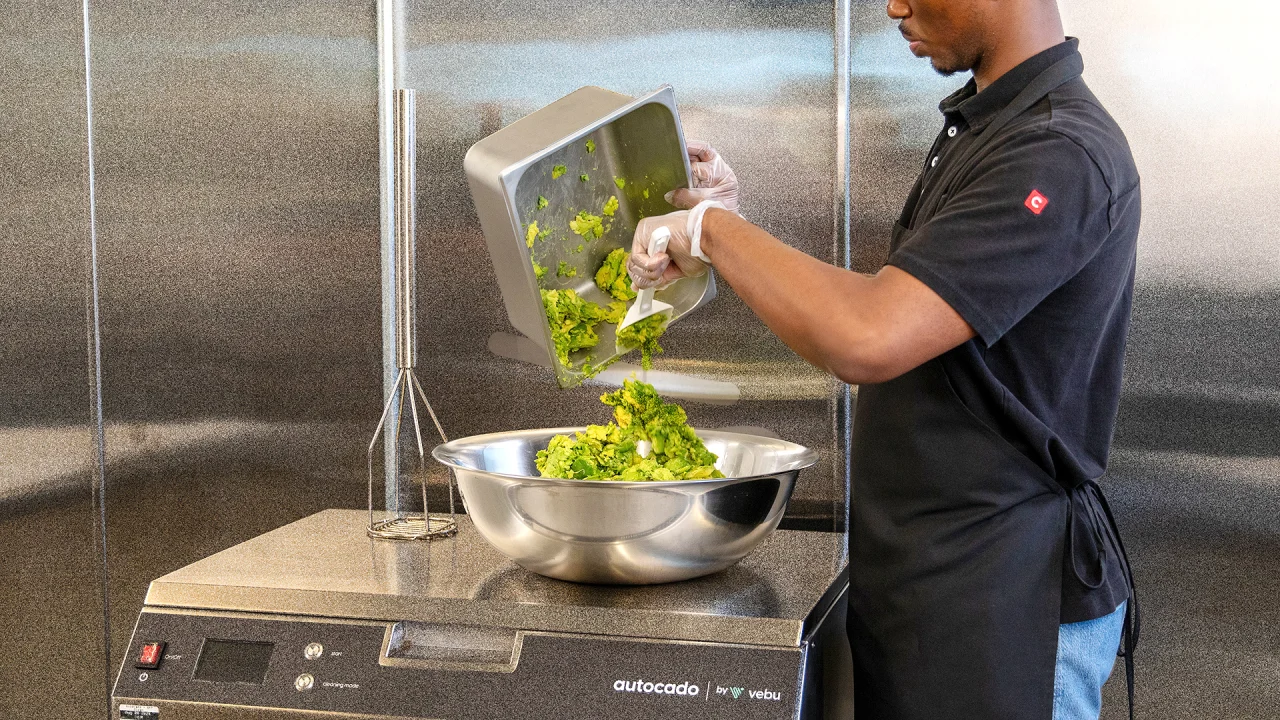Chipotle’s new robot can cut, core, and peel an avocado in 26 seconds
For the first time, Chipotle is bringing two new robots into its restaurant kitchens to help staff prep orders.Called “cobots” for “collaborative robots,” Chipotle’s new machines automate processes for avocado prep and bowl- and salad-making, but they still need human workers to complete tasks. Chipotle is using them in two California restaurants, the company announced, and they’re part of the company’s wider strategy to use technology to work faster and smarter.The Autocado cuts, cores, and peels avocados for kitchen crew to mash into guacamole. It’s being used at a restaurant in Huntington Beach. The other robot, the Augmented Makeline, is an assembly line that puts together bowls and salads for workers to lid; this one’s being used at a restaurant in Corona del Mar.The Autocado [Photo: Vebu Labs for Chipotle]Chipotle believes its cobots “could help us build a stronger operational engine that delivers a great experience for our team members and our guests while maintaining Chipotle’s high culinary standards,” Chipotle’s chief customer and technology officer, Curt Garner, said in a statement.As for whether other locations will soon adopt the new technology, Garner says the next steps will first be optimizing the machines and getting feedback from crew members and customers “before determining broader pilot plans.”The machines are both the results of Chipotle’s Cultivate Next venture fund, which the company used to invest in Vebu, the product development company that cocreated Autocado and Hyphen, which codeveloped the Augmented Makeline. Chipotle has also invested in Nuro, a delivery-focused autonomous vehicle company. Chipotle’s big investments are meant to keep the company competitive in a rapidly changing fast-food landscape, and its new robots are designed to handle tedious tasks as the chain looks to better serve both in-store and digital orders.[Photo: Vebu Labs for Chipotle]Chipotle says the Autocado takes about 26 seconds to fully flesh out the fruit inside an avocado and can recognize and adjust for the variability of avocado sizes. The Augmented Makeline is especially useful for handling digital orders, 65% of which are bowls and salads. They also free up human workers to do more of what Garner described to Fast Company as the “theater” of Chipotle, like mashing the prepped avocados and making guacamole in view of customers.Diners won’t see these robots at work because their automation is all under the hood. The Augmented Makeline’s assembly line is hidden under the top makeline where kitchen crew make burritos, tacos, and quesadillas by hand. After the lid of the Autocado is shut, its top surface becomes a counter.In keeping the robots behind the curtains, humans can then have the stage to themselves. Garner finds inspiration in cooking shows, and despite looking to bring more automation into Chipotle’s kitchens, he sees the magic of cooking as still key to the Chipotle experience. While a machine may be able to core more avocados than a person ever could, it can’t offer guests a smile and that human-to-human interaction.

For the first time, Chipotle is bringing two new robots into its restaurant kitchens to help staff prep orders.
Called “cobots” for “collaborative robots,” Chipotle’s new machines automate processes for avocado prep and bowl- and salad-making, but they still need human workers to complete tasks. Chipotle is using them in two California restaurants, the company announced, and they’re part of the company’s wider strategy to use technology to work faster and smarter.
The Autocado cuts, cores, and peels avocados for kitchen crew to mash into guacamole. It’s being used at a restaurant in Huntington Beach. The other robot, the Augmented Makeline, is an assembly line that puts together bowls and salads for workers to lid; this one’s being used at a restaurant in Corona del Mar.
Chipotle believes its cobots “could help us build a stronger operational engine that delivers a great experience for our team members and our guests while maintaining Chipotle’s high culinary standards,” Chipotle’s chief customer and technology officer, Curt Garner, said in a statement.
As for whether other locations will soon adopt the new technology, Garner says the next steps will first be optimizing the machines and getting feedback from crew members and customers “before determining broader pilot plans.”
The machines are both the results of Chipotle’s Cultivate Next venture fund, which the company used to invest in Vebu, the product development company that cocreated Autocado and Hyphen, which codeveloped the Augmented Makeline. Chipotle has also invested in Nuro, a delivery-focused autonomous vehicle company. Chipotle’s big investments are meant to keep the company competitive in a rapidly changing fast-food landscape, and its new robots are designed to handle tedious tasks as the chain looks to better serve both in-store and digital orders.

Chipotle says the Autocado takes about 26 seconds to fully flesh out the fruit inside an avocado and can recognize and adjust for the variability of avocado sizes. The Augmented Makeline is especially useful for handling digital orders, 65% of which are bowls and salads. They also free up human workers to do more of what Garner described to Fast Company as the “theater” of Chipotle, like mashing the prepped avocados and making guacamole in view of customers.
Diners won’t see these robots at work because their automation is all under the hood. The Augmented Makeline’s assembly line is hidden under the top makeline where kitchen crew make burritos, tacos, and quesadillas by hand. After the lid of the Autocado is shut, its top surface becomes a counter.
In keeping the robots behind the curtains, humans can then have the stage to themselves. Garner finds inspiration in cooking shows, and despite looking to bring more automation into Chipotle’s kitchens, he sees the magic of cooking as still key to the Chipotle experience. While a machine may be able to core more avocados than a person ever could, it can’t offer guests a smile and that human-to-human interaction.






















